Blogging Arak: Valda Gets Naked on Christmas Eve
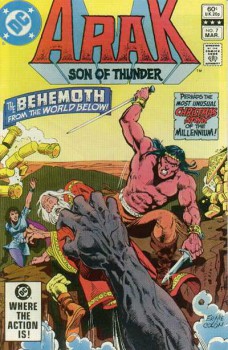 Happy Labor Day! Here you are, (hopefully) enjoying a well-deserved break from labor to spend some time on the down low at the Black Gate.
Happy Labor Day! Here you are, (hopefully) enjoying a well-deserved break from labor to spend some time on the down low at the Black Gate.
For this Labor Day edition of Oz’s ramblings and my (if I’m counting correctly) thirty-first blog post, I’m going to kill two birds with one blog by covering issues seven and eight of DC Comics’ Arak, Son of Thunder. And I’ll keep it brief. My rationale? Series creator Roy Thomas penned neither issue of this two-part story. He provided the plots, but they were written by guest scripters Gerry Conway/Mike W. Barr (7) and Mike W. Barr (8). What I’m wondering is this: Will they be able to channel the sword-and-sorcery vernacular that is old hat for Thomas? Or will their dialogue veer into self-parodic melodrama? Will it fall flat? Will it feel too modern? Let’s find out.
Issue 7: “Behemoth from the World Below!”
The cover of issue 7 boasts the caption “Perhaps the Most Unusual Christmas Story of the Millennium!” Gotta love the hyperbole. Pope dragged into the underworld by a pale giant, then rescued from the Black Pope by a Viking Native American from the unknown New World across the sea? Pretty unusual, but perhaps not the most unusual one of the past thousand years.
Arak and Valda arrive in Rome to seek the aid of Pope Hadrian to locate White Cathay and rescue the wizard Malagigi (who was carried off thence by demons back in issue 5). The “very seat of Christiandom” moves Valda to awed reverence, but Arak is less impressed.
And here we get a nice bit of exposition. It must’ve been provided by Conway (if it was not lifted directly from Thomas’s plot outline), because there are no such passages of comparable quality in the next issue:
“Wherever his gaze falls, as they ride through the marbled city’s sparsely-inhabited outskirts, Arak does indeed see signs of glory…but it is a glory long since past…the bitter shadow of a better age. Beggars crowd about them, open palms lifted, vacant faces empty of a light which once, in their ancestors, lit the world…Arak has little liking for cities in any case…yet this seems less like a city than an open grave.”
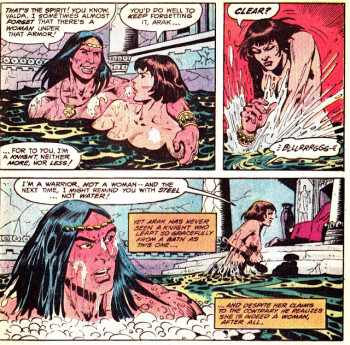 The first thing that happens after their arrival is that Arak’s honor is piqued by seeing a crowd of peasants about to stone an old man for being a Jew. The man’s silent, unflinching dignity in the face of such abuse moves Arak, and he roundly wallops some of these bigots. What really sets them running, though, is Valda’s proclamation that they serve Carolus Magnus, Protector of Rome. She puts a quick end to the violence, declaring that she does not want any blood spilt on the eve of Christ’s birth.
The first thing that happens after their arrival is that Arak’s honor is piqued by seeing a crowd of peasants about to stone an old man for being a Jew. The man’s silent, unflinching dignity in the face of such abuse moves Arak, and he roundly wallops some of these bigots. What really sets them running, though, is Valda’s proclamation that they serve Carolus Magnus, Protector of Rome. She puts a quick end to the violence, declaring that she does not want any blood spilt on the eve of Christ’s birth.
As token of his thanks, the old man offers Arak a pair of dice, explaining that he is not himself a gambler. It’s kind of amusing here that it seems we’re being set up for a bit of exposition when Arak asks, “Then why do you carry them?” and Valda immediately cuts him off with, “That sounds like the beginning of a long story, Arak…and one which we’ve no time to listen to!” (Don’t worry; we’ll get the story later on.) So they ride off to seek audience with the Pope.
They get past all the guards by presenting the scroll with Carolus Magnus’s seal. The Pope seems like a friendly old man, but he has no idea where White Cathay might lie, only that “it is a place of heresies…if it exists at all!” He suggests they go to Byzantium or Baghdad for more information. Arak is all gung-ho to get going, but the Pope then mentions that there have been many strange disappearances during this Holy Week and he wonders if the two visitors might serve as his bodyguards during the ceremonial procession later that day.
Two quick notes here:
1. It appears that the seeming foreshadowing last issue about the motives of the Monk who penned (illiterate) Magnus’s decree were red herrings, if they were intentional hints at all. Since the Pope receives them just fine, there was obviously no shady message on the scroll a la Hamlet’s lethal trick on Rosencrantz and Guildenstern.
2. Arak comes across as much more trigger-happy (tomahawk-happy?), hot-tempered, and rash in this issue. While he has always been one to speak his mind and has never suffered aristocrats or bureaucratic fools, in Thomas’s hands he has come across as having a keen intelligence that tempers his warrior spirit. He is the first to action when it becomes apparent that talking is leading nowhere; but until there is no other recourse, he has always first deferred to decorum. He knows the protocols; he just isn’t afraid to circumvent them when they are obviously going nowhere. Contrast his flowery, complimentary salutation to King Carolus Magnus on their first meeting to how he behaves when he first meets the Pope. Here he is brusque and dismissive as soon as he appears before the guy with the domed hat. We could chalk this off to his impatience to rescue Malagigi; or, more likely, it is because the dialogue here is provided by writers who are portraying their concept of a more traditional barbarian. This becomes even more starkly clear in the next issue.
The Iron Maiden Gets Wet and Naked — but don’t you forget: She’s a Warrior, not a Woman!
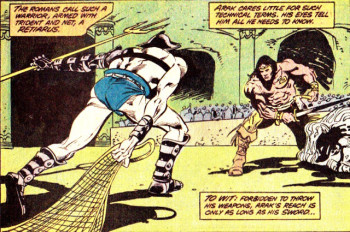 Thomas tosses Conway and Barr a “get Valda naked” scene, which they handle with, hmm, let me say one-dimensionality. After their audience with the Pope, Arak and Valda are invited to wash the road-dust off their bodies with a private dip in a Roman bath. Arak hops right in. Valda hesitates, then decides to do join him.
Thomas tosses Conway and Barr a “get Valda naked” scene, which they handle with, hmm, let me say one-dimensionality. After their audience with the Pope, Arak and Valda are invited to wash the road-dust off their bodies with a private dip in a Roman bath. Arak hops right in. Valda hesitates, then decides to do join him.
Not seeming to have learned his lesson from previous encounters, he throws his arm around her and exclaims, “That’s the spirit! You know, Valda. I sometimes almost forget that there’s a woman under that armor!”
Valda’s chilling response? “You’d do well to keep forgetting it, Arak…for to you, I’m a knight. Neither more, nor less! Clear?” She dunks him beneath the water, then leaves the bath proclaiming, “I’m a warrior, not a woman—and the next time, I might remind you with steel…not water!”
As she huffs away, the narration gives us a peek into Arak’s thoughts: “Yet Arak has never seen a knight who leapt so gracefully from a bath as this one…and despite her claims to the contrary, he realizes she is indeed a woman, after all.”
This scene makes me miss Thomas. I’ll focus a bit more analysis on it than I’m granting the rest of issues 7 and 8, because it encapsulates the deficits inherent in bringing in guest scripters.
First, the dialogue I’ve quoted from Arak does not sound like Arak. Sure, he’s put his foot in his mouth before (and caught hell from Valda for it), but didn’t sound like a salacious juvenile doing it.
Second, Valda’s response — “I’m a warrior, not a woman” — strikes my ear as so stereotypical. Given that we learned in a previous issue that her mother was also a great warrior, I just don’t think that Valda would have that stupid “a-woman-can’t-be-a-warrior” dichotomy in her mind. Of course she wants to be seen as a knight and given the full respect thereto. But I suspect that, rather than denying her womanhood, she would more likely assert that a woman can be as tough and as worthy of honor as a man. Overall, the characters just come across as having less depth and complexity here.
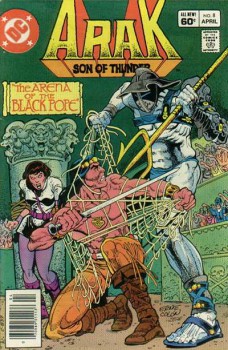 With a similar scene, like when Arak and Valda first had to sleep together for warmth, Thomas rang some poetry out of it, conveying romantic tension. Such circumstances forced the characters to be awkwardly cognizant of their mutual attraction.
With a similar scene, like when Arak and Valda first had to sleep together for warmth, Thomas rang some poetry out of it, conveying romantic tension. Such circumstances forced the characters to be awkwardly cognizant of their mutual attraction.
So, on the surface the bath scene plays out the way Roy probably plotted it; but in other writers’ hands, it falls flat. Valda’s actions do not convey suppression of her feelings (except for readers who know past context). And Arak comes across more like Bob Filner making unwanted advances on a colleague.
Okay, I’m going into brevity mode here. Just a quick rundown of how this two-part Christmas story unfolds…
During the processional, the earth trembles and a gargantuan white arm rises from the ensuing crack, snatching the Pope. Arak stabs and slices at the enormous hand, but to little avail. Valda falls in after the Pope. The rent in the earth closes and the tremors cease, leaving Arak alone to face the charge of the people that he pushed the Pope into the hole.
Another quick observation here: Thomas has never downplayed the awed, horrified, curious, or bemused reaction of Europeans to Arak’s skin tone, but Conway and Barr really go haywire with it, at one point describing him as running from the crowd on “fleet red limbs.” Every person who encounters Arak, friend or foe, immediately remarks that he is the color of Satan and appears to have come from hell. This emphasis on Arak being red has the ironic effect of making the reader notice that he does not even appear red on the page. The colorist has (wisely) chosen a more realistic bronze tone for his skin; true red would have made him look like he was from Barsoom.
[Also, I have to wonder about this: Sure, some of the Anglo-Saxon provincials who had never seen someone of another race might react strongly to someone of a different skin color; but why the reaction from those who are more well-traveled and have surely had dealings with people from the Middle East and Africa? The skin hue of some Native American tribes could perhaps be described as a slightly redder shade of brown, but the color of Satan? From a quick Internet search, I read that the term “redskin” originated in reference to particular tribes who painted their bodies red with ochre. It was then erroneously applied to all indigenous American people. Of course, “redskin” is a derogatory term that is offensive to most Native Americans. When coming from medieval Europeans, such un-PC insensitivity to Arak is obviously plausible and historically realistic. But in these issues, it often creeps into the narrative voice of the writers.]
In running from the mob on those fleet red limbs of his, Arak finds himself running down an alley to a dead-end. Just then, a door opens and that old man he rescued earlier quickly draws him inside.
Now we get the story of this guy and his dice. Turns out he is Josephus, the Jew who taunted Jesus as he carried the cross and was immediately cursed to wander the earth until Jesus returns. The dice are none other than the ones cast for Jesus’s belongings at the foot of the Cross. (I wonder what those would fetch on eBay?) Josephus gives Arak a longish exposition about all the horrors he has beheld in his eight-hundred years of wandering, then gives him the dice and shows him a way into the underworld via the catacombs.
Turns out that beneath Rome there is an underworld ruled by the Black Pope (not black in a derogatory racial sense, but because these people are the descendants of Bishop Ursilus and his followers, who were trapped in the catacombs after a fellow named Damasus stole the election from Ursilus and became Pope in his stead). A Lovecraftian touch here, as these people have mutated over the decades into tall, gaunt albinos.
Arak receives some kind of divine guidance, instinctively knowing that he should roll the dice each time he comes to a fork in the catacombs (go left on an odd roll, right on an even roll). When he is good and thoroughly lost, a “furred obscenity” that looks like a giant vampire mole attacks him (All right! Cool Monster Bonus!). For some strange reason, as Arak is shoving his torch into the creature’s mouth (look ma! No cavities!), he observes that “its eyes [glitter] with an intelligence that might once have been human!”
Oookay. That’s pretty Lovecraftian, too; but there’s no other indication that the people of the underworld have evolved into anything other than tall, gaunt humans.
Anyway, the monster’s death spasms trigger a secret trap door. Arak tumbles into an underground arena overseen by the Black Pope and all his people, who have gathered to witness the slaying of Valda and Pope Hadrian. They are tied to a pillar in the center of the arena. And that’s the cliffhanger, leading us to…
Issue 8: “Arena of the Black Pope!”
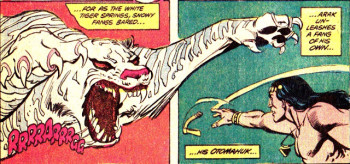 Quick note about a jarring change in the art here. Still Ernie Colón on pencils, but a fill-in inker named Bob Smith really highlights how much the inker effects the finished product. Smith’s lines are thinner, with far less embellishment. Effective at times, giving the panels with the albino tiger a striking, stylized look; but overall the characters do not look nearly as good and I miss the depth and texture supplied by Rodin Rodriguez’s “embellishments.”
Quick note about a jarring change in the art here. Still Ernie Colón on pencils, but a fill-in inker named Bob Smith really highlights how much the inker effects the finished product. Smith’s lines are thinner, with far less embellishment. Effective at times, giving the panels with the albino tiger a striking, stylized look; but overall the characters do not look nearly as good and I miss the depth and texture supplied by Rodin Rodriguez’s “embellishments.”
Mike Barr is alone on scripting chores this issue and he seems to be imitating a few stylistic tics of stereotypical sword-and-sorcery writing repeatedly. If Arak hears his words, he shows it not. If Arak notices, he cares not. If whatever, whatever not. Arak is portrayed more as the simple act-first, think-later barbarian here, which he mostly gets away with because this is strictly an all-out action issue.
The Black Pope provides a bit of exposition, including the fact that his people periodically snatch women from above-ground, especially around Christmas, “because our own women are sadly infertile…and not nearly so desirable.” Thus, among the throng of onlookers are a number of noticeably pregnant, noticeably non-albino women.
Arak challenges the Black Pope to give him a fair chance in the arena to fight for the Pope and Valda’s freedom. The Black Pope responds with three challenges.
Challenge One: A giant albino tiger, which gives Arak a run for his money.
Challenge Two: A retiarus, armed with a trident and a net (“Arak cares little for such technical terms”). With a further caveat: for this challenge, Arak is forbidden to throw his weapons (the Bad Pope saw what a well-placed tomahawk toss could do with the first challenge).
Challenge Three: A chariot, complete with driver and a second warrior with a long spear to “skewer the prey!” For this last one, Arak protests that it is not a challenge but a massacre, and to make it a fair fight he asks for his own chariot and driver. The crowd demands that his wish be granted, and the Black Pope, who “fancies himself a good monarch,” accedes to the demand. Valda is released to be Arak’s charioteer.
Of course they win all three challenges; but then the Black Pope scoffs, “You’ve won, barbarian…but did you truly think you’d go free?” No, probably not, and neither did we.
However, one of the female breeding-slave captives chooses this opportunity to drive a sword into the Black Pope’s back. Finis. That’s it for the Black Pope.
Arak, Valda, the Pope, and the Black Pope’s assassin now run through some corridors to freedom — passing along the way a gaunt giant, the one who snatched the Pope into the underworld last ish. The poor fellow is dying from the wounds inflicted on his hands and wrists by Arak, and has dragged himself off into a back cavern to die. The Pope, showing his true Christian charity, remarks, “Though he carried me to slaughter, I cannot find it in my heart to hate him.” Then they run along.
Outside the catacombs, they are greeted by Josephus, who exchanges some friendly words with the Pope before resuming his wandering. Above them all, a star shines brightly, mimicking the star of Bethlehem, “a star that shines down this night on all men!”
Merry Christmas.